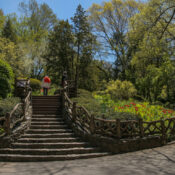“[The beauty of the park] should be the beauty of the fields, the meadow, the prairie, of the green pastures, and the still waters. What we want to gain is tranquility and rest to the mind.”
FREDERICK LAW OLMSTED, 1870
New York’s Central Park is a world-famous public park, created beginning in 1858 to address the recreational needs of the rapidly growing City. Its original purpose was to offer urban dwellers an experience of the countryside, a place to escape from the stresses of urban life and to commune with nature and fellow New Yorkers. Over 150 years later, the Park still provides this essential purpose, and welcomes all visitors, while accommodating newer forms of recreational activities. With 42 million visits a year, Central Park is one of the most visited urban parks in the country and one of the most popular destinations in New York City.
Designed by Frederick Law Olmsted and Calvert Vaux, Central Park influenced the development of urban parks nationwide and is widely regarded a masterpiece of landscape architecture. Central Park is a National Historic Landmark (1963) and a Scenic Landscape of the City of New York (1974).
Located in what is now the center of Manhattan, the site was far from the built-up areas of the City when planning for the Park began in the 1850s. Sparsely populated, it was home to small farms, industrial uses, and dwellings scattered between areas of marshland and rocky hills. The most densely populated section of the site was a settlement known as Seneca Village, highly significant as a predominantly African-American community, many of whom were property owners. Seneca Village accounts for approximately 225 of the 1,600 total residents living on the land who were displaced through the process of eminent domain.
Olmsted and Vaux designed Central Park to incorporate a variety of landscapes and experiences. Its 843 acres included sweeping lawns, picturesque woodlands, meandering streams, and broad lakes, all experienced by moving through the Park along winding paths, a carriage drive, and a bridle path. Over time, additional features were added to the Park, including baseball and soccer fields, a carousel, two skating rinks, a zoo, formal gardens, commemorative monuments, and concert and theater venues.

View in Central Park, Balcony Bridge and Oak Bridge. Photo courtesy of the New York Public Library.
In addition to diverse recreational experiences, Central Park provides great ecological and environmental benefits to the City. Its more than 18,000 trees cool and clean the air and its vast acreage in the center of the City provides habitat for wildlife, including as a stopover on the Atlantic Flyway for over 200 species of birds.
Throughout the Park’s history, pressures to add new features or use the Park for large events and non-recreational uses have threatened its purpose as a bucolic retreat from urban life. The Park has also suffered during periods of economic decline, neglect, and mismanagement. In response, New Yorkers have continuously fought to preserve the Park and uphold its original purpose. After the most recent and extreme period of deterioration, which started in the 1960s, the Central Park Conservancy was formed by a group of these citizens to rebuild and restore the Park in partnership with the City.






3 Comments
Id vim facilis ceteros percipit, altera phaedrum sea at, te alia novum praesent sit. Ne justo mazim delenit eam, pri ex brute interpretaris, invenire.
Praesent finibus congue euismod. Nullam scelerisque massa vel augue placerat, a tempor sem egestas. Curabitur placerat finibus lacus.
Ut enim ad minim veniam, quis nostrud exercitation ullamco laboris nisi ut aliquip ex ea commodo consequat. Duis aute irure dolor in reprehenderit.